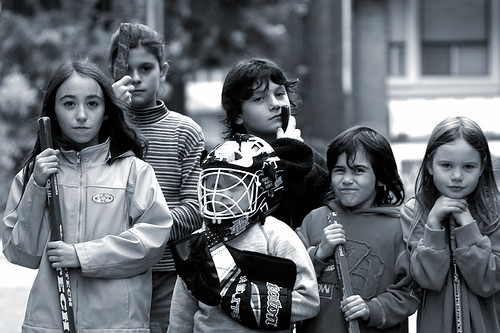

During the holiday season Spacing will re-publish articles previously seen in our print edition. This article appeared in Spacing #3, winter ’04/spring ’05.
– – – – – – – – – – – – – – – – – – – – – – – –
I was a 10-year-old revolutionary. I didn’t lead a brigade out of the jungle with lofty dreams of overthrowing a government, like the 12-year-old twins who, a few years back, led God’s Army through the jungles of Thailand and Burma. No, I simply put down a less-than-sturdy set of metal pipes and poorly tied mesh netting onto the street, like thousands of boys and girls in Toronto do every day, and reclaimed the street in the name of Hockey.
I grew up in Toronto in the neighbourhood of Willowdale. My buddies and I started off playing ball hockey on our driveways at the age of 6 or 7. By the age of 10 we were venturing into the street, where we’d spend the better part of a weekend’s daylight hours playing imagined Stanley Cup Final games that had ridiculous scores like 32-27. Cars were the sworn enemy as they’d always bring the game to a sudden halt, usually during a goalmouth scramble or breakaway. Someone would yell “Car!” or “Wheels!” and the team on the offensive would collectively moan.
There were always sweet spots to play, like a dead end. Sometimes if that spot was being used by other neighbourhood kids we’d challenge them to a game. After school, while I waited for my parents to come home from work, I’d kill time and stay out of trouble by lugging my net down the driveway onto the road to practise my snapshot or backhand. This is how I’d meet other kids who had moved on to my block — they’d come slinking down the street, a tapeless hockey stick dragging at their side, and ask if they could fire shots off with me.
Willowdale is a typical Toronto suburb, but has recently seen a condo boom along fable Yonge Street. In the ’80s and early ’90s vehicles were plentiful, but side-streets like the one I lived on were car-free enough for large street hockey games to flourish. I never realized it at the time, but we were risking our lives as human traffic-calmers. Most everyone in the neighbourhood knew that you should take the turn slowly when approaching Longmore Avenue so as not to run down a kid chasing a stray ball. Sometimes, when an aggressive driver whipped by us too quickly, we’d flick the tennis ball off a car door or rear trunk as a warning — we may not have had 3,000 pounds of metal on our side, but this was our street, too. And we had sticks in our hands.
Until recently, I thought if you ever wanted to mobilize the Canadian male population into a coherent armed resistance movement, all you would have to do is outlaw our national pastime. My theory was sadly destroyed this summer when I started to notice signs on the streets and laneways of my downtown neighbourhood declaring “Ball or Hockey Playing Prohibited — By-law 522-78”.
The City of Toronto has yet to harmonize all of the by-laws from the former cities, but as it currently stands no one is allowed to play any type of game, not just hockey, on our streets. In a post-amalgamation report on the by-law, city staff state they would like to “retain the appropriate wording in the by-law to prohibit games or sports from taking place on the road,” even though police receive very few complaints from residents about such activities. Depending on the circumstance, police can request the game be stopped and, if deemed necessary, fine each of the particpants $55. That’s a lot of candy money.
What seems to be forgotten is that street hockey is a cheap alternative to the massively expensive version played on ice. I remember as a 12-year-old witnessing my friend, who had moved to Canada from Greece four years earlier, become the best street hockey player I’d ever seen, though he had never laced up a pair of skates in his life. Street hockey brought all stripes of neighbourhood kids off rec room couches and turned them into Wendel Clarks, Wayne Gretzkys, and Patrick Roys. And it helped us learn a few things like sportsmanship and compromise.
Hockey is gloriously celebrated in our culture and national identity. The game’s importance is obviously lost on some of our traffic engineers who view the only a means of getting from here to there. But for a large swath of the population, who are too young to get behind the wheel or do not have financial means, the street offers a place to play, to learn social skills, and an opportunity for much needed exercise.
Lately, whenever I pass young kids playing hockey on the street, I internally salute them. They are some of the bravest revolutionaries we have.
photo by Matthew Blackett
